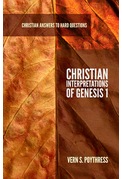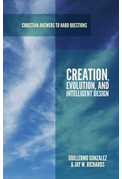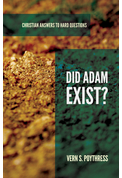P&R Publishing has done a great service for the church in publishing their growing series of booklets under the broad title, Christian Answers to Hard Questions. Taking up one “hard question” after another these booklets address issues of interest, of relevance, and of importance. Here is their list of titles in this series currently available:
Greg Beale, The Morality of God in the Old Testament
Brandon Crowe, Was Jesus Born of a Virgin?
William Edgar, How Did Evil Come Into the World?
David Garner, How Can I Know for Sure?
Guillermo Gonzalez and Jay Richards, Creation, Evolution, and Intelligent Design
Scott Oliphint, Christianity and the Role of Philosophy
Scott Oliphint, Should You Believe in God?
Vern Poythress, Christian Interpretations of Genesis 1
Vern Poythress, Did Adam Exist?
The studies tend to focus not just on essentials or fundamentals of the faith but on issues that are “hot” in contemporary discussion and/or likely to be found by the student to be under attack in the classroom. Consistently the answers given to these questions are insightful, precise, and remarkably thorough for their 30 or so small sized pages. This was a great idea, and these little booklets deserve wide use.
We have already reviewed Greg Beale’s The Morality of God in the Old Testament and noted that brings unusually helpful whole-Bible light on a question that has puzzled many. It is likely the best single help on the subject you will have in your library.
Today we will highlight three more in this series, all three focusing on some question related to the doctrine of creation.
In his Christian Interpretations of Genesis 1 Very Poythress, well-known for his interdisciplinary learning, surveys the various approaches to Genesis 1 by theologians and Christian commentators. He is fair in his representation of each view, and in under 30 pages he is able to give the reader a helpful grasp of the weaknesses and the strengths of each. He is fair, but he is not neutral, and with sufficient exegetical critique he frankly rules most options out of court. He allows the strengths of an adjusted day-age theory and the analogical day theory, as well as the young earth position. The only complaint some readers may have is that their own position was not finally vindicated, but virtually all will have to acknowledge that Poythress’s evaluations of each are judicious. This is a most helpful introduction to the discussion, advancing the careful reader well along the way in the discussion.
Poythress offers his help again in his Did Adam Exist? The discussion here treats not the biblical material (for which Poythress commends J. P. Versteeg’s Adam in the New Testament: Mere Teaching Model or First Historical Man?; P&R, 2012) but arguments that depend on science, in particular the well-known Human Genome Project.
Poythress first leads us on a quick overview understanding of the scientific processes entailed in the question of our supposed ape ancestry and points out graphically that the data is not self-interpreting, an observation that forces us to think presuppositions that inevitably influence the interpretation of data–in this case DNA data regarding the possible relation of humans to chimps. A Darwinian model will inevitably interpret similarities as evidence of descent, but a creation model can account as easily for the similarities as well as the differences. On several levels (including the so-called “junk” DNA and studies regarding the present genetic diversity of humanity) Poythress demonstrates clearly how the data in hand too often assumes the evolutionary model it purports to prove.
The scientific data related to the question of Adam and Eve is complex and still emerging at rapid pace, and already conclusions are changing within the scientific community itself. As such, the data may be overstated or misread because of underlying assumptions. Fascinating as such research is, and as revealing as it may be in various ways, it has by no means threatened the existence of the biblical Adam and Eve.
In Creation, Evolution, and Intelligent Design, by Guillermo Gonzalez and Jay W. Richards, the authors begin with definitions, stressing that we should not confuse science with naturalism and materialism, philosophical notions that so often underlie the modern scientific process. So also creationism comes in various forms: young earth creationists and old earth creationists, who also come in some varieties. But by definition all creationists hold that the world is not without purpose; it is created by God according to his purpose. The idea of purposelessness that is so essential to Darwinian evolution is scientifically unproven and unprovable. Scientists may presuppose the absence of a Creator and his involvement, but science itself cannot demonstrate it. To the contrary, scientists can demonstrate that “there are certain aspects of the universe, such as cosmological fine-tuning and nanomachines inside cells, are best explained by intelligent causes” (12). On macro and micro levels evidence for intelligent design abounds.
Moreover, even if gradualistic evolution could be proven, it cannot account for the origin of matter, of the universe, or of life. The material universe had a beginning and therefore cannot explain itself. It must have a cause, and that cause must be transcendent. And this spells the end of materialism. In brief, evidence of design is burgeoning on virtually every level. Our universe appears to be fine-tuned for life and for scientific investigation.
These little booklets are well conceived, and the issues they address are very well explained. They serve very well as an “introductory” read in issues related to creation and evolution, but the discussion goes much further than an introduction merely. Excellent for any popular use and especially so for the seminary student or university evangelism. Churches would do well to make these readily available to their members.
Fred G. Zaspel
Buy the books

CHRISTIAN INTERPRETATIONS OF GENESIS 1, by Vern S. Poythress

Creation, Evolution, and Intelligent Design

DID ADAM EXIST?, by Vern S. Poythress